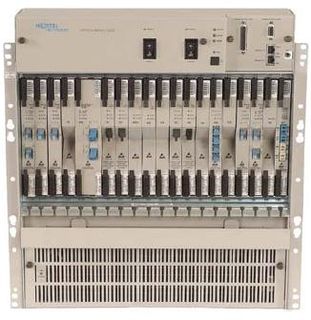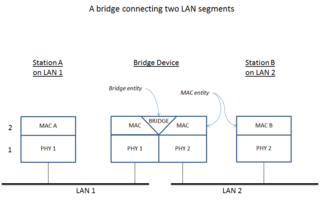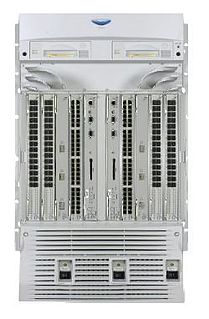The Spanning Tree Protocol (STP) is a network protocol that builds a loop-free logical topology for Ethernet networks. The basic function of STP is to prevent bridge loops and the broadcast radiation that results from them. Spanning tree also allows a network design to include backup links providing fault tolerance if an active link fails.
A virtual local area network (VLAN) is any broadcast domain that is partitioned and isolated in a computer network at the data link layer. In this context, virtual, refers to a physical object recreated and altered by additional logic, within the local area network. VLANs work by applying tags to network frames and handling these tags in networking systems – creating the appearance and functionality of network traffic that is physically on a single network but acts as if it is split between separate networks. In this way, VLANs can keep network applications separate despite being connected to the same physical network, and without requiring multiple sets of cabling and networking devices to be deployed.
A virtual private network (VPN) extends a private network across a public network and enables users to send and receive data across shared or public networks as if their computing devices were directly connected to the private network. The benefits of a VPN include increases in functionality, security, and management of the private network. It provides access to resources that are inaccessible on the public network and is typically used for remote workers. Encryption is common, although not an inherent part of a VPN connection.
IEEE 802.1 is a working group of the IEEE 802 project of the IEEE Standards Association.
IEEE 802.1Q, often referred to as Dot1q, is the networking standard that supports virtual local area networking (VLANs) on an IEEE 802.3 Ethernet network. The standard defines a system of VLAN tagging for Ethernet frames and the accompanying procedures to be used by bridges and switches in handling such frames. The standard also contains provisions for a quality-of-service prioritization scheme commonly known as IEEE 802.1p and defines the Generic Attribute Registration Protocol.
MPLS VPN is a family of methods for using Multiprotocol Label Switching (MPLS) to create virtual private networks (VPNs). MPLS VPN is a flexible method to transport and route several types of network traffic using an MPLS backbone.

A metropolitan-area Ethernet, Ethernet MAN, or metro Ethernet network is a metropolitan area network (MAN) that is based on Ethernet standards. It is commonly used to connect subscribers to a larger service network or the Internet. Businesses can also use metropolitan-area Ethernet to connect their own offices to each other.
The Multiple Spanning Tree Protocol (MSTP) and algorithm, provides both simple and full connectivity assigned to any given Virtual LAN (VLAN) throughout a Bridged Local Area Network. MSTP uses BPDUs to exchange information between spanning-tree compatible devices, to prevent loops in each MSTI and in the CIST, by selecting active and blocked paths. This is done as well as in STP without the need of manually enabling backup links and getting rid of switching loop danger.

A network bridge is a computer networking device that creates a single, aggregate network from multiple communication networks or network segments. This function is called network bridging. Bridging is distinct from routing. Routing allows multiple networks to communicate independently and yet remain separate, whereas bridging connects two separate networks as if they were a single network. In the OSI model, bridging is performed in the data link layer. If one or more segments of the bridged network are wireless, the device is known as a wireless bridge.
Provider Backbone Bridges is a set of architecture and protocols for routing over a provider's network allowing interconnection of multiple provider bridge networks without losing each customer's individually defined VLANs. It was initially created by Nortel before being submitted to the IEEE 802.1 committee for standardization. The final standard was approved by the IEEE in June 2008 as IEEE 802.1ah-2008 and has been integrated into IEEE 802.1Q-2011.
Connection-oriented Ethernet refers to the transformation of Ethernet, a connectionless communication system by design, into a connection-oriented system. The aim of connection-oriented Ethernet is to create a networking technology that combines the flexibility and cost-efficiency of Ethernet with the reliability of connection-oriented protocols. Connection-oriented Ethernet is used in commercial carrier grade networks.

Metro Ethernet Routing Switch 8600 or MERS 8600 is a modular chassis router and/or switch manufactured by Nortel now acquired by Ciena. The MERS 8600 supports the Provider Backbone Bridges (PBB), Provider Backbone Transport (PBT) technologies and carrier class Operations Administration & Maintenance (OAM) tools.
Hierarchical VLAN (HVLAN) is a proposed Ethernet standard that extends the use of enterprise Ethernet VLAN (802.1Q) to carrier networks. A number of developments have emerged in recent years to help bring Ethernet, a flexible and cost-efficient packet transport technology, to carrier networks. These developments include Q-in-Q (802.1ad), PBB (802.1ah), PBT, and PBB-TE, which bring a set of features to traditional Ethernet to make it “carrier-grade”, adding to it high-availability, OA&M, and more.
Carrier Ethernet is a marketing term for extensions to Ethernet for communications service providers that utilize Ethernet technology in their networks.
Data center bridging (DCB) is a set of enhancements to the Ethernet local area network communication protocol for use in data center environments, in particular for use with clustering and storage area networks.
Shortest Path Bridging (SPB), specified in the IEEE 802.1aq standard, is a computer networking technology intended to simplify the creation and configuration of networks, while enabling multipath routing.
IEEE 802.1ad is an Ethernet networking standard. It is as an amendment to IEEE standard IEEE 802.1Q-1998 and was incorporated into the base 802.1Q standard in 2011. The technique specified by the standard is known as provider bridging and stacked VLANs and informally as QinQ.
TRILL is an Internet Standard implemented by devices called TRILL switches. TRILL combines techniques from bridging and routing, and is the application of link-state routing to the VLAN-aware customer-bridging problem. Routing bridges (RBridges) are compatible with and can incrementally replace previous IEEE 802.1 customer bridges. TRILL Switches are also compatible with IPv4 and IPv6, routers and end systems. They are invisible to current IP routers, and like conventional routers, RBridges terminate the broadcast, unknown-unicast and multicast traffic of DIX Ethernet and the frames of IEEE 802.2 LLC including the bridge protocol data units of the Spanning Tree Protocol.
Time-Sensitive Networking (TSN) is a set of standards under development by the Time-Sensitive Networking task group of the IEEE 802.1 working group. The TSN task group was formed in November 2012 by renaming the existing Audio Video Bridging Task Group and continuing its work. The name changed as a result of the extension of the working area of the standardization group. The standards define mechanisms for the time-sensitive transmission of data over deterministic Ethernet networks.

Broadcast, unknown-unicast and multicast traffic is network traffic transmitted using one of three methods of sending data link layer network traffic to a destination of which the sender does not know the network address. This is achieved by sending the network traffic to multiple destinations on an Ethernet network. As a concept related to computer networking, it includes three types of Ethernet modes: broadcast, unicast and multicast Ethernet. BUM traffic refers to that kind of network traffic that will be forwarded to multiple destinations or that cannot be addressed to the intended destination only.



